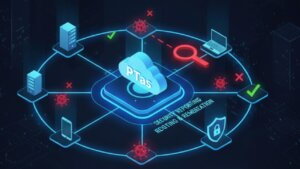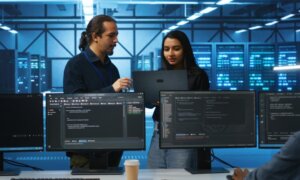Firewalls serve as one of the most critical components of a robust security infrastructure, acting as a barrier between trusted internal networks and untrusted external sources. The effectiveness of a firewall largely depends on how well its rules are configured. In this blog, we will explore the role of firewall rules in preventing cyber attacks, best practices for configuration, and the importance of continuous monitoring.
What Are Firewall Rules?
Firewall rules are predefined instructions that dictate how data packets should be handled as they enter or leave a network. These rules determine whether traffic is allowed or blocked based on various parameters such as IP addresses, ports, protocols, and application types. Properly configured firewall rules ensure that only legitimate traffic flows through the network, reducing the risk of cyber threats.
How Firewall Rules Prevent Cyber Attacks
Firewall rules play a crucial role in mitigating different types of cyber attacks. Below are some key ways they contribute to network security:
1. Blocking Unauthorized Access
One of the primary functions of firewall rules is to prevent unauthorized users from accessing a network. By setting up strict inbound rules, organizations can restrict access to specific IP addresses and ports, ensuring that only authorized entities can communicate with internal systems.
2. Preventing Malware Infections
Firewalls help in blocking malicious traffic from reaching internal networks. By using outbound rules, organizations can prevent infected devices within the network from communicating with external command-and-control (C2) servers, stopping the spread of malware.
3. Mitigating Distributed Denial-of-Service (DDoS) Attacks
DDoS attacks flood a target system with excessive traffic, rendering it unusable. Firewalls can mitigate these attacks by setting rate-limiting rules, restricting abnormal traffic patterns, and blocking requests from known malicious sources.
4. Protecting Sensitive Data
Firewall rules can be configured to prevent unauthorized data transfers. Outbound filtering ensures that sensitive information, such as customer data or intellectual property, is not leaked to external parties without proper authorization.
5. Enforcing Network Segmentation
Firewalls help in implementing network segmentation by isolating different network zones. By enforcing rules that control traffic between segments, organizations can contain potential security breaches and limit lateral movement within a compromised network.
Best Practices for Configuring Firewall Rules
To maximize the effectiveness of a firewall, it is essential to follow best practices when configuring its rules. Below are some key recommendations:
1. Implement the Principle of Least Privilege (PoLP)
Firewall rules should be designed to allow only the necessary traffic while blocking everything else by default. This minimizes the attack surface and reduces the risk of unauthorized access.
2. Regularly Update and Audit Firewall Rules
Cyber threats constantly evolve, making it crucial to review and update firewall rules regularly. Conducting periodic audits helps ensure that obsolete or overly permissive rules are removed or modified.
3. Enable Logging and Monitoring
Enabling firewall logging allows organizations to track network traffic and detect suspicious activities. Real-time monitoring helps in identifying and responding to potential security incidents before they escalate.
4. Use Whitelisting Instead of Blacklisting
A whitelist-based approach ensures that only predefined trusted sources can access network resources, while everything else is blocked by default. This is more effective than blacklisting, which can be bypassed by attackers using unknown or dynamic IP addresses.
5. Segment the Network with Different Security Zones
Dividing the network into multiple zones with different security policies enhances security. For instance, restricting access between internal systems and guest networks can help prevent unauthorized access and limit exposure to external threats.
Challenges in Managing Firewall Rules
While firewalls are an essential security tool, managing their rules effectively comes with challenges. Some of the common difficulties include:
1. Complexity of Rule Management
As networks grow, firewall rules can become complex and difficult to manage. Poorly structured rules can lead to security gaps or performance issues.
2. Performance Impact
Overly restrictive or redundant rules can impact network performance by slowing down traffic inspection and processing.
3. Human Errors
Misconfigurations due to human errors can lead to security vulnerabilities. Regular training and automated rule validation can help mitigate these risks.
Conclusion
Firewall rules play a pivotal role in preventing cyber attacks by regulating network traffic and enforcing security policies. By implementing best practices such as the principle of least privilege, regular audits, and network segmentation, organizations can enhance their security posture. However, managing firewall rules effectively requires continuous monitoring and adaptation to evolving threats. A well-configured firewall is a powerful tool in defending against cyber threats and safeguarding sensitive data.
References
Why Businesses Trust SecureMyOrg for Comprehensive Network Security
At SecureMyOrg, we uncover and fix all possible security vulnerabilities of mobile and web, while providing solutions to mitigate risks. We are trusted by renowned companies like Yahoo, Gojek and Rippling, and with 100% client satisfaction, you’re in safe hands!







Some of the things people reach out to us for –
- Building their cybersecurity program from scratch – setting up cloud security using cost-effective tools, SIEM for alert monitoring, building policies for the company
- Vulnerability Assessment and Penetration Testing ( VAPT ) – We have certified professionals, with certifications like OSCP, CREST – CPSA & CRT, CKA and CKS
- DevSecOps consulting
- Red Teaming activity
- Regular security audits, before product release
- Full time security engineers.
Relevant Posts

Why Weak Serverless Application Security Puts Your Business at Risk
Weak security in serverless environments often goes unnoticed until it leads to real damage. Misconfigured triggers, broad permissions, and poor visibility can expose sensitive data and disrupt business operations. Understanding where the risks appear is the first step toward building safer, more reliable serverless applications.

What Is Penetration Testing as a Service?
Penetration testing as a service (PTaaS) lets experts simulate real attacks to uncover vulnerabilities before hackers do. This guide explains the process, benefits, and costs, helping businesses strengthen defenses with predictable, ongoing security checks.

How To Inspect Encrypted Traffic Without Breaking Privacy
Network administrators face a challenge: securing systems while respecting privacy. This guide explains how to inspect encrypted traffic without breaking privacy using metadata, anomaly detection, and machine learning ensuring visibility, compliance, and trust.

How to Audit Infrastructure as Code (IaC) for Security Vulnerabilities
Discover how to audit Infrastructure as Code (IaC) for security vulnerabilities with this practical guide. Learn to scan IaC files using tools like Checkov, fix issues like exposed resources, and integrate audits into CI/CD pipelines. Protect your cloud systems from misconfigurations and ensure compliance with clear, actionable steps.

DevSecOps Best Practices: Integrating Security Early in Your CI/CD Pipeline
This article provides a practical guide to embedding security into every stage of your CI/CD pipeline. Learn core DevSecOps best practices like SAST, DAST, dependency scanning, secrets management, and compliance automation to catch vulnerabilities early, foster a culture of shared ownership, and build a secure-by-design development process that accelerates release cycles.

5 Cloud Misconfigurations That Lead to Data Breaches
Cloud misconfigurations are one of the leading causes of data breaches, yet they’re also among the most preventable. From exposed storage buckets to weak IAM policies, attackers exploit these mistakes daily. Learn about the top 5 misconfigurations and how your organization can fix them before they lead to costly data exposure.
